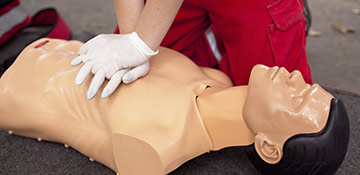Animal studies show that hydrogen gas can minimize damage caused by the production of potentially lethal compounds following cardiac arrest
Published online 6 March 2015

A dose of hydrogen gas following cardiopulmonary resuscitation could potentially improve outcomes in patients who survive cardiac arrest.
© Mihajlo Maricic/iStock/Thinkstock
Inhalation treatment with hydrogen gas protects against neurological damage in a rat model of cardiac arrest, increasing the likelihood of survival and recovery, find researchers at Keio University and Nippon Medical School in Japan.
Many patients who survive cardiac arrest remain at increased risk of death. "Neurological dysfunction, cardiac damage and systemic inflammation can contribute to their ultimate demise," explains Motoaki Sano, a cardiologist at Keio University. The stress from the one-two punch of oxygen deprivation and subsequent sudden restoration of blood stimulates the production of damaging molecules known as reactive oxygen species. These trigger inflammation and create regions of damaged tissue known as infarcts in the brain and other organs.
Sano's group has obtained evidence that this damage might be mitigated by treating patients with hydrogen after manually restoring blood circulation through cardiopulmonary resuscitation (CPR)1. "Hydrogen gas has antioxidant and anti-inflammatory properties, and limits infarct volume in the brain and heart," he explains. His team previously demonstrated that they could reduce post-cardiac arrest mortality by treating animals with hydrogen at the same time as they initiated CPR, but their investigation did not look at longer-term recovery or assess physical brain damage.
The researchers therefore embarked on a more thorough assessment of this approach in a rat model of cardiac arrest. To make their investigation more clinically realistic, they mixed hydrogen gas with normal air rather than pure oxygen, and delivered it only after normal circulation had been restored via CPR. They also tested their treatment in parallel with targeted temperature management (TTM), where a patient's body is cooled to minimize post-recovery tissue damage. "To date, TTM is the only approach proven to improve patient outcomes," says Sano.
Hydrogen treatment greatly improved survival and recovery, and even more so in combination with TTM. Of the rats that received both interventions, 86 per cent were alive one week post-cardiac arrest, compared with 38 per cent of control animals. This combination also reduced neurological damage and improved cognitive performance post-recovery. Most importantly, histological analysis showed that hydrogen treatment greatly reduced cell death and inflammation in vulnerable regions of the brain.
"This shows that hydrogen could be used as a brain resuscitation gas," says Sano. His team observed no adverse effects from treatment and has since initiated pilot safety studies in humans in preparation for formal human trials. While differences in human and rodent physiology make it difficult to predict precisely how effective this treatment will be, Sano sees a clear road to the clinic.
Reference
- Hayashida, K. et al. Hydrogen inhalation during normoxic resuscitation improves neurological outcome in a rat model of cardiac arrest independent of targeted temperature management. Circulation 130, 2173-2180 (2014). | article